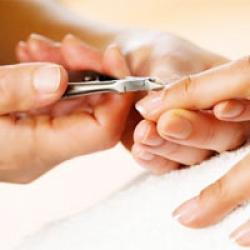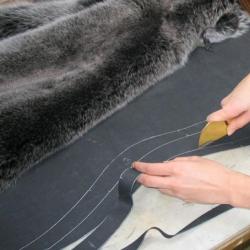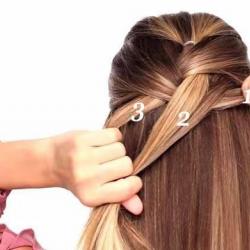Causes of hangnails. What causes hangnails on fingers and how to deal with them. What are burrs
A hangnail is a tear in the skin of the nail fold. In most cases, they occur on the lateral roll of the finger, on the side of the nail, since this area is most susceptible to mechanical stress. Also, several burrs, but much less frequently, are found on the back roller, as well as on the toes.
Externally, a hangnail looks like an area of skin detachment or a piece of skin. Such a picture does not paint the nail at all, but also causes bleeding, pain and can cause paronychia.
Causes of hangnails
The formation of such structures most often occurs on dry skin with increased sensitivity. Constant dryness when exposed to triggers can lead to thinning and loss of elasticity in the area around the nail. Even a slight impact on such weakened skin leads to cracking.
Provoking factors
Prolonged contact of the skin of the hands with water is also affected by household detergents (quite often, hangnails appear in women who do not use rubber gloves when cleaning).
Lack of proper hand hygiene.
Overdrying, chapping, frostbite of the skin of the hands, especially in winter.
Working with chemicals without using protective gloves.
Frequent walking barefoot, which is accompanied by injury to the skin of the feet from pebbles and sand.
Excessive cuticle that grows on the nail plate.
Poor quality materials used in the nail extension process, in particular methyl acrylate.
Using low-grade nail polishes and nail removers.
Injury to the skin by pebbles and sand quite often provokes the development of hangnails on the hands.
Mechanical injury to the skin during manicure and pedicure.
The bad habit of sucking fingers, biting the skin along the edges of the nail plates, and biting nails.

Internal reasons
Dehydration – failure to drink properly.
Diabetes.
Dysbacteriosis.
Gastrointestinal diseases.
Fasting, dieting, eating disorders.
Deficiency of vitamins (E, B, A) and microelements.
Complications
As with other skin lesions, in the presence of hangnails, skin defects can become a gateway for the attachment of infectious agents of fungal (Candida, dermatophytes) and bacterial (Pseudomonas aeruginosa, Staphylococcus aureus, streptococcus) infections.
Constant gnawing and tearing off of hangnails causes tissue exposure and the formation of bleeding, weeping surfaces in these places; if such places are touched, severe pain occurs.
Panaritium (paronychia) is an inflammation of the periungual fold due to the spread of infection through the soft tissues. If the finger is swollen, throbbing pain and redness occur - this is the main symptom of periungual panaritium. Subsequently, a softened area of tissue forms with a gradual change in the color of the skin to yellowish, which indicates the accumulation of purulent compartments in the periungual or subungual space.
Deformation of the nail - in some cases, paronychia can become chronic with the development of periodic exacerbations; accordingly, thickening and discoloration of the nail plate are observed.

Characteristics of burrs
Burrs can be large or small, single or multiple. Constant companions of hangnails are their pain, especially when touched, and bleeding.
Multiple hangnails make the hands unattractive and repulsive; a person with a similar problem constantly hides their hands and experiences psychological discomfort.
In addition to medical and aesthetic problems, hangnails can also complicate everyday life: they catch hair, clothing, and cause pain.
Diagnostics
The clear symptoms of the pathology do not raise any doubts during diagnosis. Particular attention should be paid to cases when hangnails, with normal care and elimination of provoking factors, begin to reappear. In such cases, additional research needs to be carried out:
stool examination for the presence of dysbacteriosis;
spectral analysis of hair for the content of microelements;
blood chemistry.
With a deficiency of vitamins, cracks may also appear in the corners of the mouth. If complications develop, when an abscess forms, it is worth performing a bacterial culture of the exudate contents to determine the causative agent of the infection and its sensitivity to antibacterial drugs.

How to get rid of hangnails at home
Steam the skin of your fingers in a hot bath for 10 minutes. Add soda or sea salt to the water (1 tablespoon per 0.5 liter).
Dry your hands with a towel, carefully and carefully.
Treat nail scissors with medical alcohol and carefully cut the cuticle. When cutting, the scissors should be held parallel, the forceps – perpendicular, for a tight fit to the skin. You should not tear off or pull the hangnails, because healthy skin will begin to tear, and conditions will appear for the formation of a new hangnail.
Treat the skin with an antiseptic solution (alcohol tincture of calendula, hydrogen peroxide), then apply Dexpanthenol (analogues of Panoderm ointment, D-panthenol, Panternol, Bepanten) or a special moisturizer to the skin.
Place an adhesive plaster with a fabric center on your fingers to prevent accidental injury to the skin of your fingers on clothing.
When fear arises when cutting off hangnails, you can use this method: at night, thoroughly lubricate the hangnails with calendula ointment and cover loosely with a band-aid. By morning, the hangnails will soften and will be removed on their own by washing your hands. But it is worth understanding that complete removal is not guaranteed, and small remnants of skin can re-cling to clothing and form new hangnails.

How to get rid of hangnails in the salon
Specialized salons perform such actions similar to home removal, but more professionally and with less risk of relapse in the future. But both the salon and the craftsmen must inspire trust, since in the process of treating burrs with an unsterile instrument, infections can be introduced. Also in beauty salons you can carry out such professional manipulations that will help prevent the development of hangnails, such as:
paraffin therapy;
peeling of feet and hands;
trim pedicure and manicure;
spa pedicure and spa manicure.
Traditional treatment
Rosehip oil or sea buckthorn oil can be applied to areas of hangnails, as they have a cytoprotective and wound-healing effect.
Aloe vera officinalis pulp. Several fresh leaves are finely crushed and applied to the fingertips, and the hands are covered with a film on top. Ideally, you need to wait for several hours, but not less than 30 minutes. Repeat the procedure 1-2 times a week.
Oil baths. Heat a small amount of vegetable oil and hold your hands in this bath for 10-20 minutes. The oil does not have to be washed off; you can rub it into the skin and put it on top of the glove. Repeat the procedure daily at night.
Treatment of complications
It often happens that a hangnail comes off, and after some time the finger breaks out. If inflammatory processes develop, you should immediately contact a surgeon.
The acute stage is treated using conservative methods: warm compresses are effective; outside the procedure, the finger must be kept in an elevated position. If necessary, the doctor may prescribe antibiotics to stop the inflammatory process and prevent an abscess.
If a periungual abscess occurs in the procedure room, drainage and opening are performed. With a subungual abscess, the nail plate may be partially or completely removed.

Prevention
Complete nutrition.
Compliance with drinking regime.
Taking minerals and vitamins. You can determine which vitamins are deficient using a blood test.
Use softening baths with soda, glycerin or sea salt twice a week.
Using softening and nourishing hand creams after each manicure session or hand washing. The cream should be applied around the nail and rubbed in using light massage movements.
Hand washing with baby soap.
Protection of hand skin from exposure to natural factors and aggressive environments (gloves, protective creams).
Eradication of the harmful habit of sucking fingers and biting nails, especially typical for children. In addition to bleeding and painful hangnails, such a habit can cause helminthic infestation or acute intestinal infection.
Disinfection after home pedicure and manicure (tea tree oil, hydrogen peroxide).
Professional foot and hand care. A high-quality trimmed pedicure and manicure virtually eliminates the development of hangnails.
Every person has encountered the problem of developing a hangnail on their fingers. A peeled piece of skin, gradually drying up, at least once in my life caused a lot of unpleasant sensations and discomfort. For those who closely monitor the external attractiveness and health of their hands, the appearance of a hangnail can greatly ruin their mood.
What is a hangnail and why is it dangerous?
 A hangnail (or hangnail) is a break in the skin on an area of the finger called the “nail fold.” Constant friction and mechanical impact on it in everyday life lead to the fact that this drying piece of skin from the finger is even more injured. The wound opens further due to the fact that the upper layer of the epidermis becomes keratinized, tightens the areas of skin around it, clings to foreign objects and gradually provokes further separation of the skin from the finger, most often quite bloody and painful. Endless wetting of the wound leads to its high sensitivity and pain..
A hangnail (or hangnail) is a break in the skin on an area of the finger called the “nail fold.” Constant friction and mechanical impact on it in everyday life lead to the fact that this drying piece of skin from the finger is even more injured. The wound opens further due to the fact that the upper layer of the epidermis becomes keratinized, tightens the areas of skin around it, clings to foreign objects and gradually provokes further separation of the skin from the finger, most often quite bloody and painful. Endless wetting of the wound leads to its high sensitivity and pain..
note
Hangnails are quite dangerous. They become gateways for the penetration of various pathogens that negatively affect organs and tissues.
The ingress of bacteria and fungi can lead to infection of the blood and skin, leading to internal inflammation and dermatological pathologies. Accumulations of pus in the nail space lead to deformation of the plate and extremely painful pulsation.
In some, especially advanced cases, you may even have to remove the nail or amputate part of the phalanx of the finger.
Burrs: reasons for formation
The appearance of skin breakage on the nail fold can be caused by a number of internal and external factors:

In cases where hand skin care is quite sufficient and extensive, there are no bad habits or traumatic factors, but hangnails still appear, you need to consult a dermatologist to determine the cause of the constant tearing of the skin next to the nail.
Diagnostic measures
In order to find out the reason for the constant formation of hangnails, the doctor may suggest the following types of examinations:

The data obtained as a result of these studies will indicate which factors of the internal or external environment have such a negative impact on the skin of the hands that it begins to peel off and dry out to the point of a hangnail.
In cases where the finger begins to rot, additional blood tests and culture of purulent contents may be performed to more accurately determine the diagnosis and the level of danger of the resulting pathology.
How to get rid of hangnails on fingers
In cases where the appearance of a hangnail is complicated by suppuration, pulsation, darkening of the skin of the finger, accumulation of pus under the nail and further uncontrolled wetting of the wound, only a specialist doctor - a surgeon or a dermatologist, depending on the severity of the patient's condition - can treat the hangnail.
Special procedures are prescribed, the finger is treated with an antiseptic and attempts are made to clean the wound as carefully as possible. Subsequently, for a faster recovery, the patient may be prescribed:
- or oral antimicrobials;
- antiseptic, healing ointments containing substances to combat pathogens;
- sprays with cleansing agents for comfortable nail care in the future.
Removing a hangnail at home
If the hangnail has not led to the formation of complications and suppuration and has moved away so that it can be carefully picked up with tweezers by the dry part, you can try to remove it yourself.
You can't keep picking off the hangnail. Separation of the upper tissues from the deeper ones can only be carried out under absolutely sterile conditions.
 Before removing a hangnail, the hands are placed in a warm bath. It is advisable to add chamomile infusion or a few drops of mint, tea tree or essential oil to the water - this will help irritated tissues calm down faster and activate protective and healing processes. After the hangnail has become soft enough, it is carefully cut off as close to its base as possible with nail scissors, being careful not to injure healthy tissue.
Before removing a hangnail, the hands are placed in a warm bath. It is advisable to add chamomile infusion or a few drops of mint, tea tree or essential oil to the water - this will help irritated tissues calm down faster and activate protective and healing processes. After the hangnail has become soft enough, it is carefully cut off as close to its base as possible with nail scissors, being careful not to injure healthy tissue.
After completion of the procedure, the affected finger is properly treated with an antiseptic.: hydrogen peroxide, chlorhexidine or miramistine.
note
You should not use alcohol-containing antiseptics, as the aggressive substances they contain contribute to drying and hardening of the skin.
Preventing the formation of burrs
To ensure that the problem of hangnails no longer bothers you, you need to take care of your hand skin every day. It should be covered at least once a day with an emollient or moisturizer. Apply it with circular massage movements until completely absorbed, paying special attention to the skin around the nails. Also, cosmetologists recommend using special oils and lotions for hands that prevent the growth of the cuticle and the appearance of hangnails.
Burrs They don’t decorate anyone, no matter whether their fingernails are long and bright or short and without any varnish at all. This problem is equally familiar to both women and men. However, women visit the manicure salon much more often, which means they suffer from hangnails much less often. If we consider appearance of burrs from the point of view of age, teenagers are more susceptible to them, due to hormonal imbalance, irregular nutrition and vitamin deficiency.
Causes of burrs
Process appearance of burrs is directly related to the loss of elasticity of the delicate skin around the nail. But not only those people who bite their nails are at risk; office workers who work a lot and for a long time with papers will definitely develop hangnails. Because paper documents dry out and degrease the skin of your hands. You also run the risk of getting this problem if you regularly work with chemicals without gloves, even if it's just dishwashing detergent or laundry detergent. If your hands are in water for a long time, and if you are not used to wiping them dry, you can also get hangnails. A lack of vitamins A and E in the body can also provoke appearance of burrs, as well as problems in the gastrointestinal tract. And, of course, improper or insufficient hand skin care can lead to excessive dry skin.
But the problem cannot be ignored, since the consequence of hangnails can be an inflammatory process of the cuticle - the nail fold (paronychia) or the entire finger (felon).
Deburring
The ideal solution to the problem would be to cover your finger with a band-aid and cut off the hangnail at home. But if you have no more strength to hold on, then use tweezers or nail scissors to cut off the painful triangle without touching the skin around it. After this, be sure to treat the wound with a disinfectant solution, it can be hydrogen peroxide, iodine or brilliant green.
But if you still wait until you get home, then soak your hands in warm water for about 10 minutes to steam the skin and remove it more effectively.
If the problem of hangnails bothers you regularly, then it makes sense to purchase special tweezers, which are very similar to nail clippers, but are equipped with triangular tips with beveled edges to fit more tightly to the skin (almost at an angle of 90 degrees). But no matter what you use to cut off the hangnail, do not pull it back, but simply trim it, otherwise you risk getting several more painful corners of the skin. The appearance of new hangnails can also be caused by cutting them with scissors, which are not able to adhere tightly to the skin.
If after deburring if redness and irritation of the skin appears, you can use one of the following medications: deperzolon, dermozolon, oxycort, geocortone, but remember that these are antibiotics, albeit for local external use.
Treatment of hangnails
Solving the problem of hangnails needs to be approached comprehensively, which means, working from the inside, enrich your diet with fruits and vegetables, as well as vitamin complexes, especially in the spring and autumn.
Working outside, make hand baths. For example, add a few drops of lemon or bergamot essential oil to hot water (tolerant for hands) and hold your hands in this water for about 10 minutes, then dry your hands with a napkin and lubricate them with nourishing cream. If there are no essential oils, then you can make the same bath with the addition of a few drops of olive or even vegetable oil; it also perfectly softens the skin of your hands. It is more useful to do such baths in the evening before bed to avoid going outside and give your hands proper care.
You can try the old “grandmother’s” method - treatment with iodine, probably painful, but, according to reviews, very effective.
If burr left behind a wound, quick healing is possible with the help of the “Rescuer” balm, which will heal and soften the skin, helping to quickly get rid of the problem.
Preventing the appearance of burrs
Replace regular soap at home with liquid soap, preferably one based on soap root; it will not dry out the skin of your hands so much. And be sure to dry your hands with a towel after washing your hands.
To prevent appearance of burrs You also need to take care of your hands regularly, nourishing them daily, softening and moisturizing them with cream, as well as doing a manicure at least once every two weeks, but not less often. It is better to have a specialist do the manicure, then the problem of hangnails will bypass you. But if you do a manicure yourself and do not intend to change your habit, then do not abuse cuticle softeners, since they do not benefit your nails, but the skin around the nails may suffer. In any case, when using such products, strictly follow the instructions for use. And also know that all manicure tools must be made of medical steel and well sharpened, so it is better to purchase manicure sets in specialized departments or stores.
Be aware that quick-drying nail polish is harmful and can cause appearance of burrs.
It is useful to drink a lot of fluid, since its lack in the body leads to drying and cracking of the nail plate and the appearance of burrs.
Also, for home therapy, cosmetologists recommend using vegetable oils, which should be rubbed warm into the cuticle. You can also purchase ready-made oils for nails and cuticles, for example, almond oil. At the pharmacy you can purchase a special pencil with tea tree oil, which will help cope with the problem of hangnails, acting as a moisturizer and antiseptic.
Such an unpleasant problem as hangnails on the fingers is certainly familiar to each of us. It should be noted that it is only at first glance that they seem to be a safe phenomenon. In addition to the fact that they cause a lot of inconvenience, hangnails become inflamed and painful when they become infected, and if they are not treated properly, they can lead to an abscess. Unfortunately, it is impossible to completely get rid of this problem, but proper care and prevention will help prevent such a problem from occurring.
Reasons for appearance.
It should be noted that hangnails may be present on the fingers and toes. The main culprits of this problem are the lack of regular care of the skin of the hands and nails, as well as the bad habit of biting nails. A significant role in their occurrence is also played by chemical detergents and cleaning products, which we use every day in everyday life, washing powders, and prolonged contact of hands with dirty water. In most cases, women forget about protecting the skin of their hands and do not use household gloves when cleaning and washing, which contributes to the appearance of hangnails: the skin surrounding the nail plate begins to dry out, becomes rougher, and as a result, cracks appear.
Out of habit, many of us, when a hangnail appears on our finger, try to tear it off or pick it out with our fingernail. Remember! Under no circumstances should this be done, even if this trouble arose at the most inconvenient moment and causes a lot of inconvenience. It’s better to be patient and at home, maintaining sterility, carefully remove the hangnail. Tearing them off the fingers can lead to injury to healthy skin tissue, and as a result, to tearing, resulting in a focus of inflammation. Untreated hangnails can contribute to the development of inflammation of the nail fold (“paronychia”) or, even worse, inflammation of the finger (“felon”).
The cause of the appearance of hangnails on the fingers can also be more serious problems - various disorders in the body. In particular, with a lack of vitamins and nutrients in the body, and when it is weakened, hangnails become a common occurrence. In addition, hangnails can occur against the background of gastrointestinal diseases and dysbacteriosis. Therefore, if hangnails appear frequently, it is recommended to consult a dermatologist and undergo the necessary treatment.
By the way, this problem worries the male part of the population much more often, which is due to the tendency of men’s skin to be dry and rough. In addition, according to most men, hand skin care is a purely feminine activity and is not for men.
Delete.
If, despite all precautions, the skin is cracked and burrs still appear, it is imperative to remove them. To do this, you should first steam the skin, for which a warm bath is perfect. You should add a little essential oil to the water, in particular bergamot or lemon oil. If you don’t have such oils, you can use regular vegetable oils. You should keep your hands in this bath for no more than fifteen minutes. Then, using special nail clippers, carefully trim off the burrs. The movements should not be pulling or tearing; you must bite, otherwise injury to healthy skin will occur.
If there is no hangnail, but the skin around the nail plate is very rough, then using a sanding file you can remove the rough layer. At the end of the procedure, the sanded area should be treated with a disinfectant solution, in particular a solution of hydrogen peroxide.
If hangnails cause severe discomfort, it is recommended to moisturize them with cream or lubricate them with medicinal ointment at night. This will help soften the skin and make it easier to remove hangnails.
Folk remedies.
The most common remedy is baths for hands and nails. Oil baths are very beneficial for the skin and are highly effective. They require little time, so they can be used daily. It is necessary to heat a little vegetable oil (olive, almond, sunflower, etc.) and hold your hands in it for twenty minutes. The oil softens and nourishes the skin, preventing the formation of this unpleasant problem. The oil can simply be rubbed into the skin of your hands and nails and left overnight, wearing cotton gloves.
For existing hangnails, a warm soda bath is recommended. It is prepared like this: a tablespoon of soda is diluted in 500 ml of water. Keep your hands in this bath for ten minutes. As soon as the skin has steamed, you need to cut off the burrs with gentle movements. If the hangnail bleeds, treat with a disinfectant, and then apply olive oil to the skin of your hands and cuticles for five minutes, after which the skin should be blotted with a cosmetic or paper napkin.
A bath with sea salt and essential oils of bergamot and lemon also prevents the appearance of hangnails. Baths should be done constantly. They can be alternated.
Houseplants such as aloe and kalanchoe can also help fight hangnails. Thanks to their anti-inflammatory, bactericidal and wound-healing properties, these plants help to heal the skin around the nails and heal existing cracks. For treatment, you should grind several clean and dry Kalanchoe leaves. The resulting slurry should be applied to the tips of each finger, and wrapped with cling film on top (also each finger separately). This kind of mask must be left on for several hours, so it is best to do this procedure at night. You can evaluate the effect after several procedures: the skin will become elastic, and you will forget about this problem. Just to maintain the effect, you should not forget to do the procedure at least once a week.
Cosmetic preparations for the treatment of hangnails.
There are no special cosmetic preparations intended for the treatment of hangnails, since everything necessary is contained in creams for the care of the skin of the hands, cuticles and nails. The cream should be applied to the base of each nail and rub in with light massaging movements until it is absorbed. It is advisable to carry out this procedure every day, and if necessary, several times during the day (after washing dishes, cleaning, etc.).
Prevention.
To eliminate this unpleasant problem, you should constantly and carefully care for your own hands, nourish, moisturize and soften them with creams, use medicinal oils, herbal and oil baths, and also, if possible, reduce interaction with an aggressive environment. With even the slightest contact with detergents, it is necessary to thoroughly wash your hands using liquid soap or, better yet, baby soap, because it contains moisturizing and bactericidal substances. In addition, it does not dry out the skin so aggressively. After this, the skin should be thoroughly dried with a towel and a moisturizing or nourishing oil-based cream should be applied.
Trimming manicure is considered the most effective preventive method, since during the procedure the cuticle is completely cut off. Carrying out this procedure regularly will help you forget about this unpleasant problem. You can also do a manicure at home, but in this case you should not overuse cuticle softeners. In addition, we should not forget about the sterility of the instruments used during manicure. It is best to use professional manicure tools, since they are made of medical steel and are perfectly sharpened.
By the way, quick-drying nail polishes are harmful and can cause hangnails. Therefore, you should not abuse it.
It is very important to maintain a drinking regime, since a lack of water in the body leads to dry skin, which leads to cracking and the appearance of hangnails.
You can use tea tree oil as a moisturizer and antiseptic against hangnails.
Before leaving the house, especially in the cold season, you should lubricate the skin of your hands with a protective oil-based cream for half an hour.
In spring, the skin needs vitamins, so take vitamin and mineral complexes for skin, hair and nails.
Nutrition against hangnails.
Eating daily helps prevent this problem. In particular, your daily diet should include more foods that contain vitamin A or retinol (carrots, best eaten with sour cream). This substance perfectly moisturizes the skin and stimulates its restoration process. You can replenish the reserves of this vitamin in the body with the help of a pharmaceutical preparation, an oil solution of vitamin A.
As a result, we can conclude that regular care, proper nutrition and protection of hands when conducting household and other work will relieve such an unpleasant phenomenon as hangnails.
The main reason for the appearance of hangnails is dry skin, which occurs with frequent contact with water, household chemicals, paper, as well as wind and frost. An unbalanced diet, or more precisely, a deficiency of fats and vitamins A and E, may also be to blame for the lack of moisture.
Those who like to bite their nails also suffer from hangnails, as this unsightly habit weakens the nail bed and leads to microtrauma to the skin around the nail plate.
A poorly done manicure can also play a role, especially if the cuticle is cut off.
Finally, the state of health in general and the digestive system in particular plays an important role.
If you watch your diet, take care of the skin of your hands and do not have the habit of biting your nails, but hangnails still do not go away, this is a good reason to consult a doctor.
How to prevent hangnails
The best means of prevention is to protect your hands from anything that dries your skin, as well as regular use of moisturizing cosmetics. Therefore, it is advisable to do all housework with rubber gloves and apply cream to your hands as needed, and not just before bed.
Make sure your diet includes foods rich in fats and vitamins: fish, vegetable oils, nuts, vegetables, fruits and herbs.
Get a hygienic manicure regularly, preferably unedged. Instead of cutting the cuticle, rub special oil into it and gently push it with an orange stick to the base of the nail. If you can’t completely avoid trimmed manicures, do them as rarely as possible so that the skin has time to recover.
Not . This not only leads to the formation of hangnails, but also increases the risk of infection of the wound by bacteria living in the oral cavity. And getting bacteria into your mouth from your hands can have very unpleasant consequences.
Smussyolay/flickr.com
Give preference to nail polish remover without acetone. Products with ethyl acetate, isopropyl alcohol and propylene carbonate do not dry the skin as much. It would be nice if the liquid contained glycerin or oil extracts.
Do not overuse quick-drying nail polishes, as they not only quickly harden themselves, but also instantly dry out the skin around the nail.
How to properly remove burrs
If it’s too late to do prevention and unpleasant pieces of dry skin are puffing up on your hands, then there’s nothing left to do but get rid of them. But removing does not mean biting off, tearing off or tearing off. Here's how to do it correctly:
- Soak your fingers in a bath of warm water and a few drops of vitamin E or olive oil.
- Trim the hangnail flush with the skin using sharp scissors or nail clippers. Do not pull or pull: this may injure the skin. And try not to cut off too much so that a wound does not form.
- Lubricate the cut with antibacterial ointment: this will prevent infection and speed up healing.
- If you had to remove a large hangnail that had become severely torn from the skin, cover the cut with a band-aid.
- If the patch is of no use, moisten the cut. Vitamin E or moisturizer is suitable for this. Apply the product several times throughout the day, especially after contact with water.

What happens if you get hangnails, and how to treat it
A hangnail that is not treated in time can lead to inflammation of the nail fold, also called paronychia or periungual felon. If the skin around the hangnail is red, swollen, or purulent, this indicates a bacterial or fungal infection.

At the initial stage of inflammation, when the area around the hangnail is red and slightly swollen, warm water baths can help. They need to be done 2-3 times a day.
If after 3-4 days the inflammation does not go away or progresses, you should consult a doctor. You will most likely be prescribed a course of antibiotics, and if it does fester, you may need to drain the infected area of skin.
If you are diagnosed with fungal paronychia, you will be prescribed appropriate antifungal medications.






